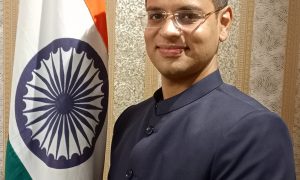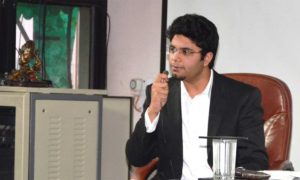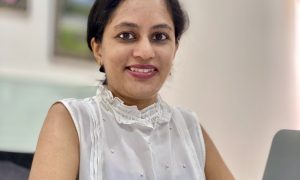This interview has been published by Namrata Singh and The SuperLawyer Team

Dr. Kalyan, as a founder, could you give us an overview of BananaIP Counsels and describe your current responsibilities within the firm?
Absolutely. At BananaIP Counsels, we pride ourselves on being a forward-thinking IP firm that is not only technology-driven but also champions diversity, with a strong emphasis on women leadership and inclusivity of persons with disabilities. Our combination of technological specialization, legal expertise, and business insight allows us to provide high quality IP services to clients.
Our firm has specialized departments led by experienced partners in various technology sectors. Additionally, we also have focused departments dealing with Trademarks, Copyrights, E-commerce Law, Entertainment Law, Open Source Law, and Technology Law, some of which are integrated IP divisions.
In my current role, I lead the innovation, consulting, and strategy department of the firm. Our department focuses on the strategic IP needs of our clients, and the professional growth and knowledge development of our associates. We handle strategic and complex IP projects that cover a broad spectrum, from IP mining and audits to devising IP protection strategies, and from resolving disputes to facilitating licensing and commercialization efforts.
Interesting! We noted that this year marks the 20th anniversary of BananaIP Counsels. Could you share some insights into the firm’s evolution and highlight some of the key milestones achieved along the way?
BananaIP Counsels is marking its 20th anniversary this year, having initially taken root in IIM Bangalore’s entrepreneurship cell (NSRCEL) back in 2004 as Brain League IP Services. Our journey through the years has been a tale of survival, stabilization, and success. Despite the hurdles and destabilizing events encountered along the way, we have achieved at least part of what we set out to do. We believe that our efforts have contributed to the current IP ecosystem in India at different levels. Overall, our endeavors over the past 20 years have fostered IP knowledge development, human capital growth, policy and legislative advancement, and the enhancement of IP service standards.
From your experience, what is your assessment of the current IP landscape in India? Additionally, can you tell us your predictions for its development over the next decade?
Over the past twenty years, the Intellectual Property (IP) system has witnessed considerable advancements in terms of IP filing numbers, the processes and systems introduced by the IP office, enforcement mechanisms, and the judiciary’s responsiveness. As of now, the IP system in India can be described as ‘reasonably friendly’.
Despite these advancements, there remains substantial work to be done to cultivate an IP ecosystem in India that is both business-friendly and equitable. Currently, the system faces challenges such as limited accessibility, inconsistency and diversity in Court processes and speed, difficulties in digital IP enforcement, an underdeveloped licensing framework, and low hygiene levels. Over the next five to ten years, I anticipate progress in these areas, and I also expect a significant rise in IP filings and registrations.
I believe the upcoming decade will be a ‘golden era’ for IP in India.
With the ongoing discussions around Artificial Intelligence (AI) and its influence across sectors, what impacts do you foresee AI having on the field of IP, specifically regarding IP management and practices?
Today’s discussions on AI encompass a range of IP issues, including protectability, ownership, enforcement, and dispute resolution. While important, these topics will not be the focus of this response. Instead, I will briefly touch upon how BananaIP is leveraging AI in our operations and our future plans for its use.
BananaIP has always been an early adopter of technology, and we have developed several tools to enhance the quality and efficiency of our work. Currently, we utilize AI to assist us in reviewing and refining our work products, and to supplement some of our file management and communications. Due to concerns over confidentiality, we do not use AI for drafting patents and designs at this time.
Additionally, we have developed complementary tools that aid in file management and the review of competitor filings. We are also in the process of creating predictive and analytical tools aimed at automating audits, portfolio management, and project documentation.
While General AI has the potential to draft legal documents, the quality of its current output does not yet meet our firm’s standards. However, we anticipate significant advancements in this area, and believe that AI will soon be capable of producing first drafts that exceed the quality produced by our new recruits. Although we do not foresee AI replacing IP professionals in the near future, we do expect a notable adjustment in the distribution of tasks and responsibilities.
Looking ahead, our goal for the next three years is to develop proprietary tools that will assist us in creating certain deliverables, reviewing projects, and automating manual processes. Whether we like it or not, I believe that the IP profession has to adapt to the advancements in AI technology, and we must reconsider some of our current practices.
Based on your experience, do interdisciplinary teams having technology, law and business experts work well together? What has your experience been?
Our experience with interdisciplinary teams has been excellent. The interdisciplinary approach at BananaIP fosters a stimulating and intellectually rewarding work environment. Our operational model blends the openness of research labs with the structured discipline of law firms. Our team comprises technology specialists, many of whom are also qualified patent agents or attorneys with a deep understanding of the law. Our lawyers specialize in IP, and have an open mind to learning the science and technology relevant to their work. They bring unique perspectives and contributions to each project, which add significant value to our work products.
We have learned that BananaIP does not function like a typical law firm, and has a unique culture. Can you tell us about your culture and values?
BananaIP offers a welcoming, intellectually stimulating and open work environment. We value balancing work and life as much as we value our clients’ IP and business needs. Unlike many IP law firms, we don’t have a strict hierarchy and rigid structures. Our structure is mostly flat. Diversity, equity, and inclusion are integral to our culture and values.
Honesty, integrity, and dedication to our client’s cause form the core of all our services.
You have been talking a lot about accessibility off late, why do you believe accessibility is crucial for the IP system?
One of the primary objectives of the IP system is the benefit of the public. It promotes creativity and inventive activity, and grants exclusive rights over inventions and creations with the objective of eventually benefitting the general public. This objective is achieved through access, disclosure and publication of ideas and creations, and unless these are fully accessible, a large portion of the public will not be able to benefit from them. In other words, accessibility of the IP system and disclosures plays an important role in achieving the ultimate goal of public benefit, and if there is no accessibility, the very purpose of the IP system will not be served. Therefore, it is important to make the IP system fully accessible to everyone, and to ensure that no one is left behind.
In your interactions, you have often highlighted the suitability of the IP profession for individuals with disabilities. Could you explain your perspective on this?
Certainly, to start with, let me state that I am a person with blindness, and I have been able to successfully practise as an IP attorney. This of course would not have been possible without the help and assistance of my colleagues, and confidence reposed in me by my clients. From my experience in the field, I strongly believe that the IP system is very suitable for persons with disabilities. Many reasons led me to this belief, and I will tell you three of them:
A. Firstly, IP filing and prosecution is today fully online, and one can practise this without the barriers relating to physical movement and inaccessible premises. Several Courts have also gone online, and have taken some steps to facilitate accessibility of documents and materials.
b. The IP Office has issued accessibility guidelines, and has established a system to seek reasonable accommodations. While there is much to be done to make its online systems fully accessible, the IP Office has shown the intent to do so. This makes it relatively easy for persons with disabilities to overcome accessibility hurdles, and participate fully/equally in the IP process.
c. To get into this profession, a person with a disability need not be a lawyer. Persons with any degree can qualify as trademark agents, and persons with a technical background can get into the patent profession.
Overall, the IP profession is welcoming, and companies are not too uncomfortable in working with persons with disabilities. In my opinion, if a person with a disability is looking for an option that provides independence, autonomy, and respectability, the IP profession is a good choice.
You have been interacting with the Indian IP Office to improve accessibility to persons with disabilities. What do you think the IP Office must do to make its systems and processes accessible to persons with disabilities?
The IP Office has taken an important step by releasing guidelines to improve access for all. However, this intention needs to be put into practice effectively. The IP Office must take the following steps:
a. The IP Office should organize training sessions to educate their staff about the needs of individuals with disabilities and highlight the importance of providing access. Currently, many officials believe that they have the right to refuse accessibility requests, thinking that the rules in IP laws are more important than the requirements of the Rights of Persons with Disabilities Act. Changing this mindset will make it easier for individuals with disabilities to engage with the IP Office.
b. It is also important for the IP Office to enhance the accessibility of its online platforms. Despite some progress, their systems do not meet essential accessibility standards. Improving the accessibility of their filing systems and documents would be significantly beneficial.
c. Furthermore, the IP Office has to consider issuing guidelines or circulars that require the submission of documents in an accessible format. This will ensure that everyone, including those with disabilities, can access these documents easily. Many High Courts have already required documents to be submitted in a format that is readable by optical character recognition (OCR), and the IP Office should follow this example.
By implementing these measures, the IP Office can facilitate full and equal participation of all individuals, including those with disabilities, in the IP process.
These steps do not seem very complex, and we hope the IP Office will look into them seriously. We noted that you recently published a book on accessibility entitled ‘Understanding Accessibility’ in which you have pointed out that everyone can contribute to accessibility. Can you tell us how we can do that?
Well, if you have the intent and willingness to make a difference, you may consider the following simple steps:
- Share any document or information you file or distribute in accessible formats. This is easy, and you may consider doing this for all types of documents you share in general, or file before Courts or Tribunals. Here is a link that gives accessibility guidance for word documents, PDFs, and PPTs: https://www.adcet.edu.au/inclusive-teaching/accessible-content/accessible-documents
- Whenever you share something on social media, ensure that you include alternative text, image descriptions, video captions, etc. Most social media and messaging platforms have enabled these features, and all you need to do is spend an extra minute to make your post, photo, video, or document, accessible. You will find some accessibility tips at this link: https://disabilityin.org/resource/creating-accessible-social-media-content/
I hope you will consider incorporating these as a part of your day to day interactions and engagements.
Thanks a lot for giving me this opportunity.
Get in touch with Dr. Kalyan C. Kankanala–


























